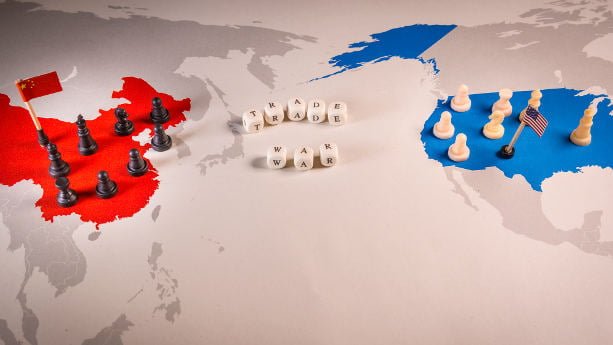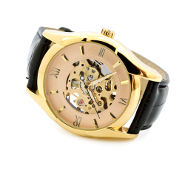
Like many others, I assumed the US-China trade war would be a short affair. I envisioned some deal involving mutual trade concessions taking place in a matter of weeks.
How wrong I was.
Now we are facing the prospect of a decade-long trade war, that will possibly mark the end of an era. Given that the United States is our main market, in terms of users, the trade war has a severe impact on our business too.
I’m not here to discuss which side is morally right or wrong. But I do have an obligation to share my views of how the US-China trade war may impact small businesses in the US, importing from China.
- Why the trade war could massively benefit Chinese sellers
- Which products are affected by the new tariffs?
- Which products are not affected by the new tariffs?
- What does this mean for US importers?
- Will China or the US win the trade war?
The trade war also comes with some unintended consequences, that have the potential to backfire massively.
Important update regarding the increased US-China tariffs
As of September 2019, the added tariffs apply to the majority of products imported from China. By December, we can expect all products (with some exemptions) imported from China to the US to be subject to a 15 to 25% tariff. As trade talks have seemingly stalled, it’s essential for importers and Amazon sellers to prepare for what is likely the new normal:
1. All companies importing to the US are affected by the new tariffs, including non-US companies importing as a foreign importer of record
2. These tariffs may even increase further in the future. It all depends on whether the US and China can reach some sort of deal.
3. For many product categories, it’s still not an option to simply shift orders to suppliers in other Asian countries. For most categories there simply are no factories outside of China. Hence, your option is most likely to either pass on the new tariffs to your customers – or not buy products at all.
This trade war so far (Updated October 4th, 2019)
The trade war is an ongoing affair, with two rounds already in place, and more to come.
| Round | Amount | Rate | Industries | Link |
| July 2018 | $34 B (Active) | 25% | Machines, tools | Link |
| Aug 2018 | $16 B (Active) | 25% | Chemicals, machines | Link |
| Sep 2018 | $200 B (Active) | 25%* *Increased from 10% to 25% in May 2019 | Seafood, furniture, electrical equipment, bags & luggage | Link |
| September 2019 | $125 B | 15% | Textiles, electronics, footwear, other consumers products (with some exemptions) | List 4A |
I would also like to thank Gary Huang of 80/20 Sourcing for providing the initial product lists.
What going to happen next?
We are now at a point where the majority of goods imported from China to the US are subject to the added tariffs. Without a trade deal between China and the United States, it’s likely that we’ll see the tariffs being increased further.
25% is not the upper limit. Washington has already hinted that the tariffs can go even higher.
Products affected by the US-China tariffs
Tariffs initially targeted machinery and tooling, such as lasers and gas vessels. As such, the first two rounds had a limited impact on American e-commerce companies and Amazon sellers. A few examples follow below:
- Dental cement
- Iron or non-alloy steel semi-finished products
- Caps, lids, seals, stoppers and other closures, of noncellular vulcanized rubber other than hard rubber
- Stainless steel, width 600mm+, hot-rolled flat-rolled products, in coils, w/thick. 3 mm or more but less than 4.75 mm
- Textile calendering or rolling machines
- Storage water heaters, non-electric
- Fire extinguishers, whether or not charged
- Brewery machinery,
- Textile printing machinery
- Molds for rubber or plastics, injection or compression types, other than for shoe machinery or for the manufacture of semiconductor devices
That said, the third round – covering $200 billion worth of imports from China – is far more comprehensive:
- Bags, cases and similar containers (certain materials only)
- Seafood (fish, other)
- Luggage and suitcases (certain types and materials)
- Gloves (certain types and materials)
- Furniture (certain types and materials)
- MDF
- Raw silk
- Prefabricated buildings
- Electric lamps and lighting fixtures
Products (previously) not affected by the US-China tariffs
So far, most ‘eCommerce products’ are not targeted. For example, the following categories are not subject to a 25% import duty rate:
- Watches
- Consumer Electronics
- Apparel & Textiles
- Kitchen Utensils
- Toys & Children’s Products
- Accessories & Jewelry
UPDATE: This list of product categories are now subject to a 15% tariff
A 10% to 25% duty rate is likely to become the new normal
Currently, there is no end in sight to the US-China trade war. This situation could take decades to resolve, effectively becoming the new normal.
Importers need to assess if they can absorb a 25% cost increase, and plan accordingly.
Chinese companies keep selling duty-free into the US
Cross-border e-commerce, mainly through platforms like Aliexpress.com and Wish, has completely exploded in the last few years. This has largely been fueled by two things:
1. Packages valued below a certain threshold get cleared through customs tax-free. As such, a lot of products enter the US tax-free, while American importers must pay duties on bulk shipments.
It’s not a loophole. It’s perfectly legal.
This quote is directly from the US customs:
Packages whose declared value is under $800 ($100 if being sent as a gift to someone other than the purchaser) will generally be cleared without any additional paperwork prepared by CBP
In fact, the ‘duty-free’ threshold was increased as late as 2016.
2. Chinese online sellers get massive ePacket discounts when shipping to the United States, but not the other way around. It’s often cheaper to send a widget from China to the US, than within the US itself.
American sellers were already at a major disadvantage, as you are taxed on the entire customs value. It’s no secret that Chinese companies, on Amazon and on Aliexpress, have gained a plenty of ground.
2. Throw in a 25% tariff in the mix, while Chinese sellers still get away with 0%
Additional tariffs would make it impossible for American importers to compete – on their home turf. If the US government decides to go this way, and implement more China tariffs, then they must also ensure that cross-border shipments are taxed at the same rate as ‘regular imports’.
Somehow, I doubt that will happen.
3. Is the future of US e-commerce dominated by Chinese sellers?
Imagine yourself browsing Amazon a few years from now, only to find that everything single product is shipped from sellers in Mainland China.
If the US decides to administer ‘death by a thousand taxes’ to its domestic importers, then this is actually a realistic scenario in only a few years.
The Chinese may not have caught up with the US in most areas, but they are damn good when it comes to ecommerce and logistics.
Let’s look at what the United States would lose in the process:
- Hundreds of thousands of jobs (if not millions) and the tax revenue generated
- Product development and marketing expertise (this where the US reigns supreme)
- Losing control of product compliance
Learn more about import duty thresholds and subsidized shipping
- Duty-Free Threshold: U.S. Customs and Border Protection – Internet Purchases
- ePackets: As U.S. Postage Rates Continue To Rise, The USPS Gives The Chinese A ‘Free Ride’
Simply ‘taxing the e-packets’ is not as easy as it might sound. We’re talking about tens of millions of parcels on a yearly basis.
What should US Importers do?
Given the likelihood that the situation continues to escalate, it’s high time for American importers to consider their options.
Option 1: Move to Hong Kong and become a cross-border seller
If you can’t beat them, join them. If it’s impossible to compete, as an American business paying taxes in America, then perhaps your business to Hong Kong.
From Hong Kong, you can sell cross-border and enjoy multiple tax perks offered to cross-border sellers:
- Low profit taxes (8% – 16.4%)
- Sell duty-free into the United States
- Lab testing? Who cares…
I understand that this is not a realistic option for most small business owners, with a mortgage and a family. But I want to demonstrate the absurdity of the situation.
Option 2: Source manufacturers in Vietnam and India
Go on Alibaba.com and search for watch manufacturers in Vietnam, and you’ll have a grand total of zero suppliers to choose from.
When it comes to many product categories, China is simply the only option. Sourcing suppliers in other Asian countries can work for certain categories, such as textiles and furniture, but not for all.
The same can be said about domestic manufacturers in the United States. Many of the low-cost products we take for granted today, were not low-cost products in the 60s and 70s – because there were never any low-cost watch assemblers in the US or Europe.
Notice that I just refer to watches to make a point here.
If you can change to a supplier elsewhere, then something you should absolutely consider. However, for most, that’s not an option.
In addition, Vietnam and India aren’t exactly laissez-faire free market havens either. It might only be a matter of time until additional tariffs are slapped on goods from these countries too.
Option 3: Pass on the cost to the consumer
Some brand-centric businesses might be able to get away with a price increase, to absorb the increased tariffs. But most do not have that luxury.
Option 4: Shut down
This might be the only realistic option for the majority of companies, in case all Chinese imports are taxed by a 25% tariff.
I’m sure that Chinese sellers would love to see their US competition just roll over and die.
Option 5: Avoid targeted product categories
Assuming the new tariffs will remain limited to specific categories, you can simply target products that are not on the tariff list. That’s, of course, easier said than done and only works for as long as a blanket tariff on all imports is not implemented
Option 6: Sell elsewhere
Importers based in the United States are not subject to US-tariffs when shipping products to other countries and markets, such as the EU, Canada, Australia, and Japan.
This might be the right time to start looking at markets outside the United States.
Will China or the US win the trade war?
Many self-proclaimed LinkedIn experts are not shy to speculate on why it’s absolutely certain that China will win this trade war on walkover. They state that China can ‘simply wait it out’.
What is not entirely clear, however, is what such a victory would look like.
Will the US simply abolish all tariffs on Chinese goods, while China is allowed to maintain high tariffs and non-tariff barriers to foreign imports in perpetuity?
Will the US pay ‘trade war reparations’?
Or perhaps, fly in Pompeo to kowtow on prime time in Beijing? All of this is, of course, absurd, and will never happen.
There aren’t necessarily any winners in this war
China stands to lose a lot. Contrary to many ‘expert claims’, you can’t simply make up for a lost market by exporting your goods elsewhere. Anyone with even the slightest business acumen understands this.
Yes, China can ‘wait it out’, and face enormous losses in the process.
When it comes to the United States, it’s a matter of both investing in the domestic industry, and help suppliers in Vietnam and India expand into new products. But for now, China is the number one manufacturing base for a vast range of products.
That said, as I explained earlier in this article, the US stands to lose a lot more if American importers are priced out of the market.
Either way, nobody is going to ‘win’ this trade war.
Will China eventually give in to US pressure?
No, at this stage, it’s impossible for the Chinese to simply ‘give in’ to US demands. Doing so would be a huge (domestic) political risk that Beijing can’t afford.
If there is ever a deal to be made, it must be something similar to the EU – China solar panel tariff negotiations a few years back.
Rather than the EU slapping a tariff on Chinese made solar panels, they took a much more pragmatic stance and ‘helped’ the Chinese save face by agreeing to a minimum unit price.
Same result, different approach.
What should the United States do?
I’m not American and have never lived there, so I rather not lecture the US in how to run their own country. That said, I think the following measures would be effective:
- Abolish subsidized ePacket shipping
- Abolish tax-free cross-border imports
- Offer tax incentives to manufacturing businesses
This would go a long way to level the playing field while stimulating the domestic industry.
Further, we shouldn’t forget that a large share of China’s worldwide exports is US-owned. Nor should we forget that many of the products manufactured in China today, where never manufactured at scale in the United States, to begin with.
That said, I don’t imply that these tariffs are without merit.
I understand why this is happening.
What do you think?
This article is partly based on unfolding events, partly on speculation from my side. Leave a comment below to share what you think about the ongoing trade war.






















Great article, thanks. I am based in Germany but I am planning to import electronic products in the price range of 20-40§ shipped from China (Aliexpress) to the US. Do I understand it right that there is now a 15% tariff on that? If so, how do I pay it? Does Aliexpress keep the 15% directly, or do customs contact my customer in the USA, or me?
Hi Luke,
Not sure if the tariff applies to toys at this point. However, Aliexpress doesn’t collect import duties.
Also, keep in mind that most toys sold on Aliexpress are not CPSIA compliant.
Hi Frederik,
thanks for getting back. Yes, you are right, but the product is more in the electronic niche but nothing with toys. If Aliexpress doesn’t collect import duties and tariffs, how to pay those instead?
Best,
Luke
Hi Luke,
Either through the air courier company or directly to the customs authorities
So toys, apparel, and baby products still unaffected?
It depends on the specific product (or HS code, more specifically), but the current tariffs are not mainly targetting consumer goods. It’s likely that Trump will focus on other tools (like with Huawei) before adding tariffs on low value-added consumer goods that have no real strategic importance for Washington. But, I’ve been wrong before!
How do I find out specifics on materials being ordered from China if they are affected. Specifically, how can I check what the % tariff would be on importing Polyester fabric rolls?
This is interesting.
But isn’t the upcoming quitting of Universal Postal Union and the end of terminal dues will end the advantage of e-packet?
As a sell in the US, i am counting on that day.
Yes, I would think so too. That said, the $800 duty threshold is not related to the Universal Postal Union as far as I know. Assuming it remains, cross border sellers will gain a real advantage.
So, just to clarify-small purchases from AliExpress will not increase in price, shipping costs or be affected? I import on a very limited small scale (maybe only 2 or 3 of a design) in crafting supplies and generally purchase items with free shipping here to the USA and then resale across various online platforms. It sounds like from your list above, this would fall under toys and kid’s items and should not change. Great article and very helpful, by the way.
Correct!
As a New Yorker who has had to listen to Trump whine and open his huge mouth for the past several decades, I’m a little worried. To all those who still think he’s great at negotiating-all I can do is laugh and say to read the facts. Not one human in history has lost the amount of money that he has. Is it 10 failed or bankrupted businesses? That’s who’s negotiating? His ONLY claim to fame is licensing his name (and some have fought to remove it), and the rest is a big show. China is smart and strategic – – own a huge part of our debt and has a good hand-to play as these tariffs hurt the US more than China. Trump cares nothing about tariffs, taxes, health care, immigrants, etc.— only thing he cares about is his ratings. I’d personally take the tariff hit if it wakes up his followers and he’s gone in 2020. That’s the only way our free nation will survive, let alone cheap priced imports from China.
Is this a Trump tax abuse, in actuality? Since the importer in the US is required to pay these tariffs before receiving their shipment, and this money goes directly to U.S. Customs/the federal government…. isn’t this in effect a ‘tax’ increase on American consumers and businesses without having to go through congress to raise taxes in order to raise federal revenue out of the U.S. Consumer?? ? A tax abuse the scale of Boston Tea Party is the only way I can see this since, truly, we don’t even make MOST of the items we import from China to call it anything related to a genuine or in direct interest of our manufacturing. Is this a reasonable assumption on my part?
Enjoyed your perspective, thanks!
Thank you Chase!
So when you live in hong kong you can get away without paying any tariffs?
This means the whole amazon market place will get taking over by chinese sellers.
Yeah, that’s a risk. I don’t want to see that happen as work closely with many hard working American companies. That doesn’t mean that I think Chinese sellers should be banned.
Thanks for sharing the article. Interesting article to share. keep up the good work.
Thank you Angela!
Do you know that China and Vietnam just open border to each other and Vietnam will accept Yuan currency for China to dump all their goods into Vietnam before sending to US to avoid the tariff measure by Trump.
So don’t expect that Vietnam will be able the new “replacement” of manufactures for goods from China. For sure that Trump’s Administration is aware of this as happend with steel from Vietnam, which actually from China.
Vietnam is being ruled and lead by Chinese Communists 1000 %, so we won’t expect anything good from Vietnam for now.
Do a webinar about this.
Hi Ryan,
That’s a good idea! I will certainly mention this during our upcoming webinar with Alibaba.com
Let’s not get carried away by Trump’s negotiation tactics. He is making a big announcement and is bringing the Chinese to the negotiation table.
That’s his way of doing business. Many times, he told the investors “Oh, we need an extra 500 million, otherwise we can’t finish the building”, and then it all gets settled through negotiations.
Apparently it’s also his way of negotiating on international trade barriers. I’d actually say it’s not a bad tactic to adopt when the counterpart is Chinese.
Yes, I have been thinking about this from the same angle.
It sounds scary when both sides drop figures like ‘500 billion’ in new tariffs… and I guess that’s the point.